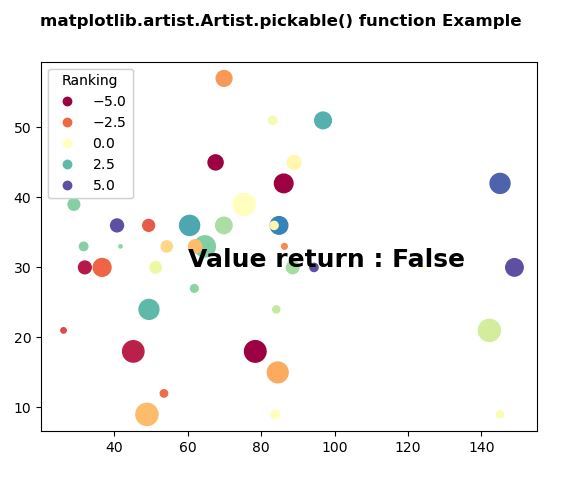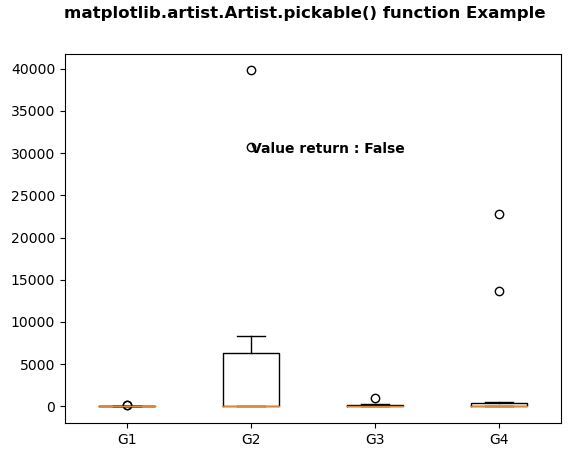Matplotlib.artist.artist.pickable()
Python matplotlib库的artist模块中的pickable()方法用于返回artist是否可选取。
语法:Artist.pickable(self)
参数:该方法不接受任何参数。
这个方法返回artist是否可以被选中。
下面的例子演示了matplotlib中的matplotlib.artist.artist.pickable()函数:
示例1
# Implementation of matplotlib function
from matplotlib.artist import Artist
import numpy as np
np.random.seed(19680801)
import matplotlib.pyplot as plt
volume = np.random.rayleigh(27, size = 40)
amount = np.random.poisson(10, size = 40)
ranking = np.random.normal(size = 40)
price = np.random.uniform(1, 10, size = 40)
fig, ax = plt.subplots()
scatter = ax.scatter(volume * 2, amount * 3,
c = ranking * 3,
s = 0.3*(price * 3)**2,
vmin = -4, vmax = 4,
cmap = "Spectral")
legend1 = ax.legend(*scatter.legend_elements(num = 5),
loc ="upper left",
title ="Ranking")
ax.add_artist(legend1)
ax.text(60, 30, "Value return : "
+ str(Artist.pickable(ax)),
fontweight ="bold",
fontsize = 18)
fig.suptitle('matplotlib.artist.Artist.pickable() function\
Example', fontweight ="bold")
plt.show()
输出:

示例2
# Implementation of matplotlib function
from matplotlib.artist import Artist
import numpy as np
import matplotlib.pyplot as plt
import matplotlib.cbook as cbook
np.random.seed(10**7)
data = np.random.lognormal(size =(10, 4),
mean = 4.5,
sigma = 4.75)
labels = ['G1', 'G2', 'G3', 'G4']
result = cbook.boxplot_stats(data,
labels = labels,
bootstrap = 1000)
for n in range(len(result)):
result[n]['med'] = np.median(data)
result[n]['mean'] *= 0.1
fig, axes1 = plt.subplots()
axes1.bxp(result)
axes1.text(2, 30000,
"Value return : "
+ str(Artist.pickable(axes1)),
fontweight ="bold")
fig.suptitle('matplotlib.artist.Artist.pickable()\
function Example', fontweight ="bold")
plt.show()
输出:

 极客教程
极客教程